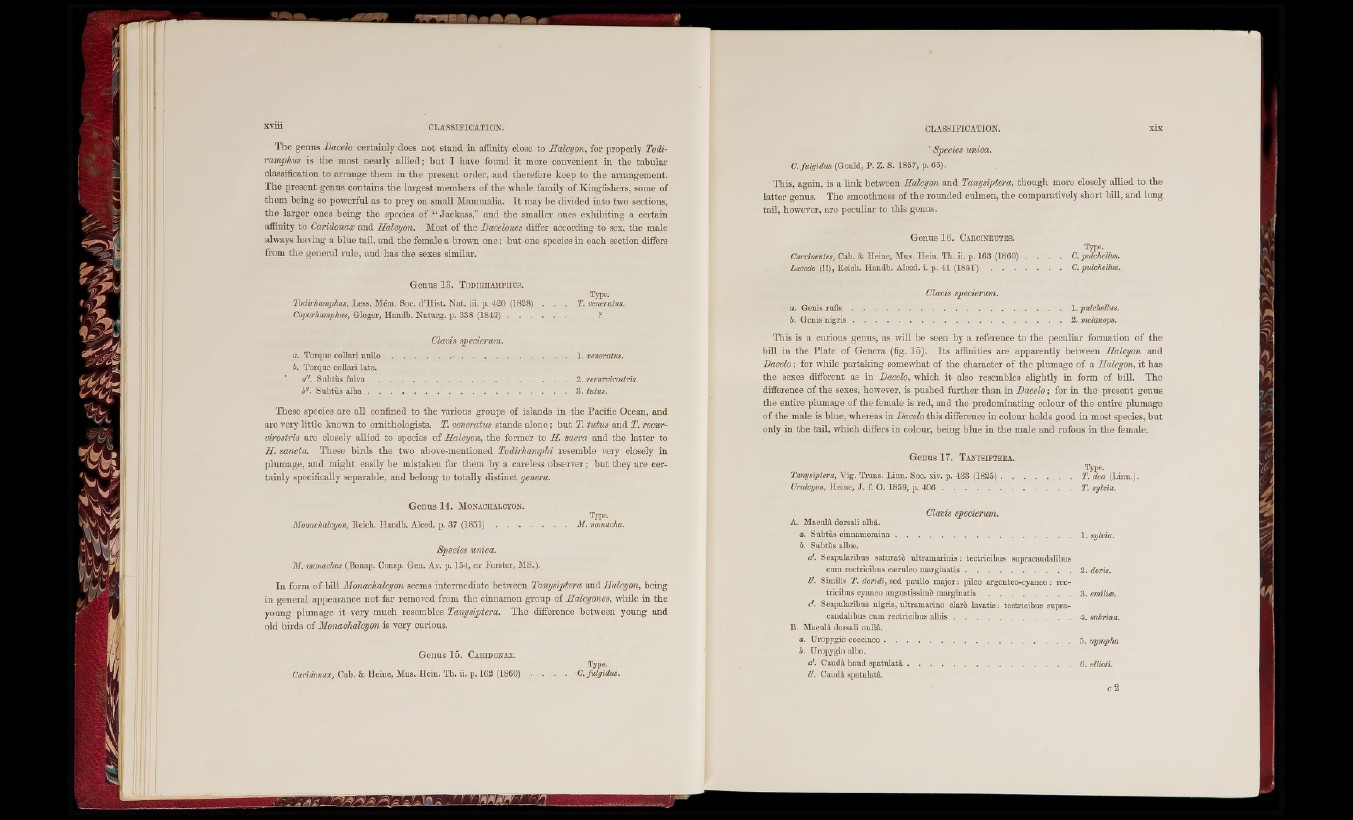
T h e genus Dacelo certainly does n o t stand in affinity close to Halcyon, for properly Todi-
ramphus is th e most n eaiiy a llied ; b u t I have found it more convenient in the tabulai-
classification to arrange th em in th e present order, and therefore keep to th e an-angement.
T h e present genus contains th e largest members o f th e whole family o f K ingfishers, some of
th em being so powerful as to prey on small Mammalia. I t may b e divided into two sections,
th e larg er ones being th e species o f “ Jackass,” and the smaller ones exhibiting a certain
affinity to Caridonax and Halcyon. Most o f th e Dacelones differ according to sex, the male
always having a blue tail, and the female a brown one ; b u t one species in each section differs
from th e general rule, and lias th e sexes similai-.
Genus 13. T odirhamphus.
Type.
Todirhamphus, Less. Mém. Soc. d 'H is t. Na t. iii. p. 420 (1828) . . . T. veneratus.
Coporhainphus, Gloger, Handb. Natm-g. p. 338 ( 1 8 4 2 ) ..................................... ?
Clavis spedemm.
a. Torque collari n u U o ............................ • ...........................................................I . veneratus.
b. Torque collari lato.
fl". Subtùs f u l v a .................................................................................................. 2. recurvirostris.
b". Subtùs a l b a ....................................................................................................... 3. tutus.
These species are all confined to th e various groups o f islands in the Pacific Ocean, and
a re very little known to ornithologists. T. veneratus stands alone ; b u t T. tutus and T. recur-
virostris are closely allied to species o f Halcyon, th e former to H. sacra and th e la tter to
H. sancta. These bird s th e two above-mentioned Todirhamphi resemble very closely in
plumage, and m ig h t easily be mistaken for them by a careless observer; b u t they are certainly
specifically separable, and belong to totally distinct genera.
Genus 14. M o n a c e a lc y o n .
Monachalcyon, Reich. Handb. Alced. p. 37 (1851) . . .
Type.
M. monacha.
Species unica.
M. monachus (Bonap. Consp. Gen. Av. p. 154, ex Forster, MS.).
In form o f bill Monachalcyon seems intermediate between Tanysiptera and Halcyon, being
in general appearance n o t far remo\’ed from th e cinnamon group o f Halcyones, while in the
young plumage i t very much resembles Tanysiptera. The difference between young and
old birds o f Monachalcyon is very curious.
Genus 15. Caridonax.
Cízri¡/o7ía:p, Cab. & Heine, Mus. Ilein. Th. ii. p. 162 (I860) . . . . C.fulgidus.
■ Spedes unica.
C.fulgidus {Gould, P. Z. S. 1857, p. 65).
This, again, is a lin k between Halcyon and Tanysiptera, th o u g h more closely allied to the
latter genus. The smoothness o f th e rounded culmen, th e comparatively short bill, and long
tail, however, are peculiar to this genus.
Genus 16. Carcineutes.
Type.
Camnewíeí, Cab. & Heine, Mus. Hein. Th. ii. p. 163 (1860) . . . . C. pulchellus.
Lflce<io {!!), Reich. Handb. Alced. i. p. 41 ( 1 8 5 1 ) ......................................... C. pulchellus.
Clavis specierum.
a. Genis r u f i s .............................................................................................................1. pulchellus.
b. Genis n i g r i s ............................................................................................................2. melanops.
This is a curious genus, as will be seen by a reference to th e peculiar formation o f the
bill in the Plate o f Genera (fig. 15). I ts affinities a re apparently between Halcyon and
Dacelo; for while partaking somewhat o f the character o f th e plumage o f a Halcyon, i t has
th e sexes different as in Dacelo, which i t also resembles slightly in form o f bill. The
difference o f the sexes, however, is pushed fu rth e r th an in Dacelo; for in th e present genus
the entire plumage of the female is red, aud the predominating colour o f th e entire plumage
o f the male is blue, whereas in Dacelo this difference in colour holds good in most species, b u t
only in the tail, which differs in coloni-, being blue in th e male and rufous in th e female.
Genus 17. T anysiptera.
-a, Vig. Trans. Linn. Soc. xiv. p. 433 (1825) .
Uralcyon, Heine, J . f. 0 . 1859, p. 406 .............................
Type.
T. dea (Linn.).
T. sylvia.
Clavis 5
A. Maculâ dorsali albâ.
a. Subtùs c in n amom in a............................................................................................i . sylvia.
b. Subtùs albæ.
a'. Scapularibus saturate ultramarinis : tectricibus supracaudalibus
cum rectricibus cæruleo m a rg in a tis .........................................................2 . doris.
b'. Similis T. doridi, sed pauUo major : pileo argenteo-cyanco : rectricibus
cyaneo angi^tissime m a i - g iu a t i s .............................................3. emilia.
c'. Scapularibus nigris, ultramai-ino clare lavatis : tectricibus supracaudalibus
cum rectricibus a l b i s ..............................................................4, ;
B. Macula dorsali nulla.
a. Ui-opygio coccineo.................................................................................................5 .
b. Uropygio albo.
a'. Caudâ baud s p a tu la tâ .....................................................................................6. ellioti.
b'. Caudâ spatulatâ.
c 2